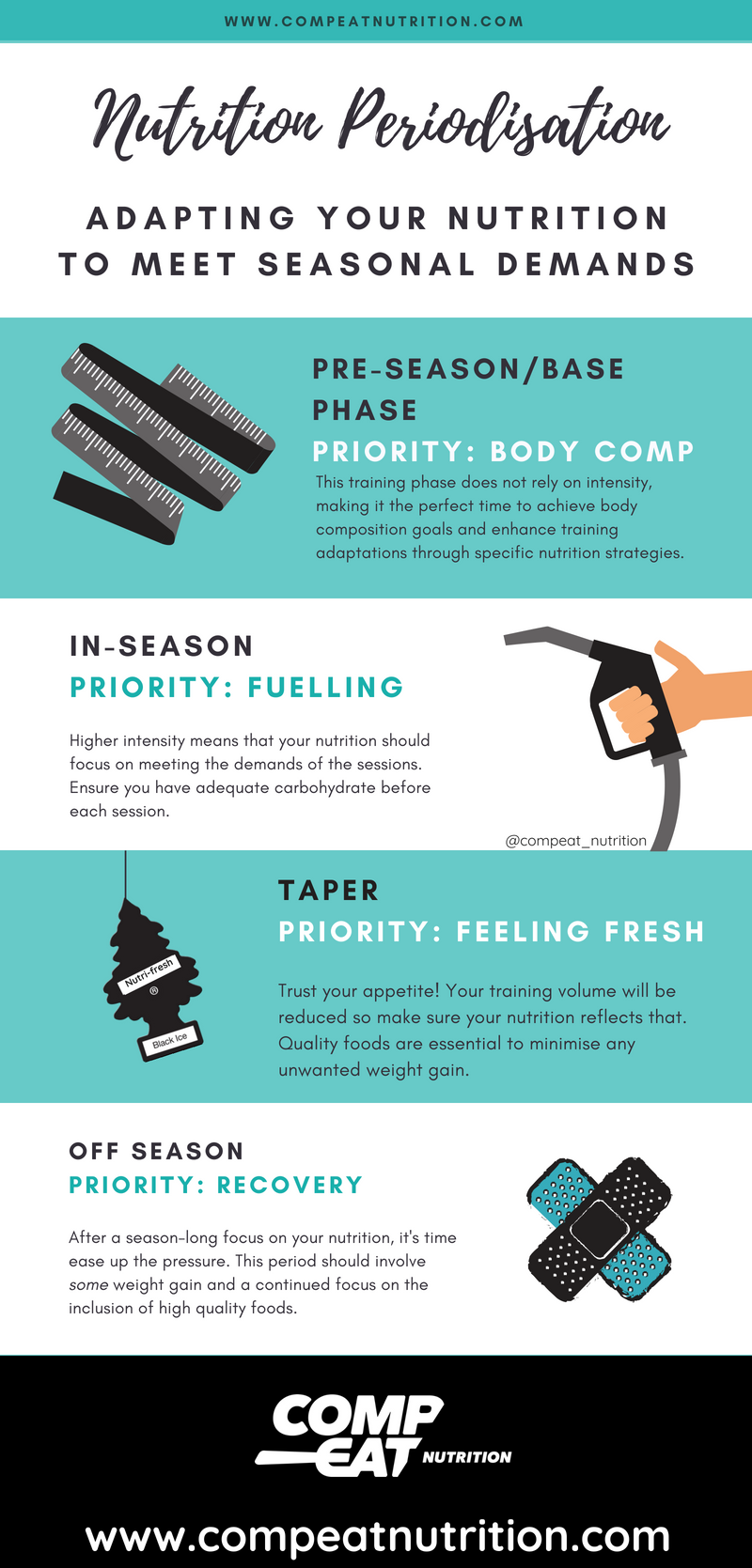The 4 Phases to Performance using Nutrition Periodisation
Depending on the type, timing, frequency and intensity of your training sessions, your body responds and adapts differently. Training periodisation is all about long-term variations in your training to improve performance. Did you know that your nutrition can also be used for adaptation? Research is making it increasingly clear that the adaptations from exercise can be both dampened or amplified with nutrition choices and timing.
Nutrition periodisation is all about changing and adapting your intake in response to the different periods of training and racing. Some of these concepts are new, while others you may have heard about or even do already. Each of these concepts need to be timed within your training/racing program appropriately and are not ideal to do year-round. Sports Dietitians are experts in these concepts, so if you would love some individualised advice on how to incorporate nutrition periodisation into your training, it is one incredible investment (ok, so I am a little biased!).
The Macrocycle: Adapting your intake year all round
The macrocycle refers to your training program over the entire season, and how your training changes depending on the time of year to ensure maximum performance for your key races.
Pre-Season/Base Phase – Priority: Body Comp & Aerobic Capacity
In endurance sport, you will usually have a base phase initially. This is where you enter (or re-enter) the training scene with the goal of building endurance and fitness.
Sessions are usually low to moderate intensity and are not yet focused on achieving those top end speeds. This is the time to really nail your nutrition to achieve a specific body comp you may be aiming for. The reason that this is the ideal time to alter your intake, is that this phase does not rely on intensity and you can actually enhance exercise adaptions by altering carbohydrate availability. There is no need to ‘diet’ or restrict to achieve this – adapting intake through the types of food you are choosing can be enough.
During this phase, you will naturally need less carbohydrate overall. This is because you are simply not dipping into your muscle glycogen stores how you would during high-intensity sessions. Simple strategies such as keeping carbohydrates to a ¼ of a plate at main meals or simply switching your favourite carb options for a lower energy alternative – e.g. bulking up your usual spaghetti serve with some zoodles.
This is also the time that you can acutely alter carbohydrate availability by ‘training low’. Options could include training in a fasted state, training twice per day, training with restricted carbohydrate intake or even sleeping with low carbohydrate availability.
In-Season – Priority: Fueling
As intensity ramps up and there becomes a bigger focus on quality sessions, nutrition to support your training demands becomes increasingly important. A lack of adequate fuelling going into a key hill or interval session can prevent you from getting maximal gains from the session, as goal intensities may not be able to be achieved.
In this phase, reduce the amount of sessions that you ‘train low’ for and instead concentrate on ensuring adequate carbohydrate intake around key sessions. It is best that significant weight loss isn’t aimed for during the season and to instead focus on weight maintenance and adequate fueling to maximise what you can get out of each session. In terms of your plate, it may now look like 1/3 plate carbohydrate – particularly on heavier training days.
Taper- Priority: Feeling Fresh
As you approach a key race or event, your training load will be tapered. The focus moves to feeling fresh, sharp and rested for race day. As the training volume is reduced, ensure your nutrition intake reflects this.
Trusting your appetite during taper is essential, as it will likely reduce along with your lower training load. Ensure you continue to choose quality foods despite the added freedom, as this will minimise any unwanted weight gain as you approach the important day.
If your event would benefit from carbohydrate loading, this is the time to consider prioritising carbohydrate rich foods with the goal of maximising muscle carbohydrate (glycogen) stores. Finding a balance between indulgence and performance is so important here though – carbo loading is one of the most common sports nutrition strategies we see athletes doing incorrectly.
Off-Season - Priority: Recovery
This is where the likelihood of increasing body weight and fat mass is highest. For many lean athletes, it is essential that weight is increased slightly here to assist with regulating hormone levels and maintaining a good immune system. So if your weight cycles throughout the season slightly, this can actually have some real positives.
To manage your health and body composition during this downtime, concepts are similar to the pre-season phase. As muscle glycogen demands are much less, your intake of carbohydrate can be reduced to reflect this.
However, instead of focusing on what you should remove in this phase, instead focus on what you can add in! Aim to consistently add plenty of salads and veggies to your meals – that way you will naturally reduce overall energy intake without going hungry or missing out!

The Microcycle: Adapting your intake during the week
We couldn’t cover how to adapt to seasonal demands without considering the microcycle. The training microcycle refers to the pattern of training that you follow over the week. This is all about how the length and intensity of your sessions change depending on your work and lifestyle commitments, and also what works best for optimum performance.
Periodising your nutrition around the weekly microcycle is a concept that can be tricky at first, but if you chat to an experienced Sports Dietitian, they will be able to train you to do it yourself automatically in no time at all! The benefits of adapting your intake daily to match your training demands are extensive. The biggest one many athletes find is that they can achieve a better energy balance, improve adaptations to training and maintain body composition at their goal levels. Also, by fueling those tough sessions adequately, you will find that you can maximise your performance and hit the goal intensities of each session.
For higher training days, where the sessions are longer or harder, your body will require additional energy and carbohydrate. This is because your need for muscle glycogen is higher as your heart rate increases. To achieve this, ensure you are eating frequently over the day, timing intake around your sessions and prioritising carbohydrate more than usual. This could mean adding a high-quality carbohydrate source to your salad for lunch, or having a more carbohydrate centric meal for dinner such as a rice or pasta dish.
On recovery/lower training days, the intensity of any sessions is lower, so your energy and carbohydrate requirements are also reduced. To match this, reduce your portion sizes of carbohydrate where possible and instead replace it with higher fibre, lower energy dense foods – options like salads and veggies are perfect. This ensures that you remain full and satisfied, as overall food volume and variety remains high. All that colour also helps boost your immune function to cope with the risk of illness while training hard over the week!
Summing Up
All endurance athletes will have different goals, body compositions, nutrition needs, recovery opportunities, training programs, lifestyle factors and training schedules. With this, there is no one program that is going to meet the needs of all athletes. However, by considering your training and competition cycle, it is possible to maximise the fueling and adaptations to be gained to then enhance performance.
To give you an idea on what this may look like from Compeat, we have differing tiers of support that all come with continuous and unlimited nutrition support.
Our Specific Membership is a daily menu that considers your lifestyle demands, individual training program and goals – our periodisation around these are stepped out daily. If you are just starting out, wanting to gain confidence and love detail, this membership is going to be a winner!
Our Flex Membership works as a graduation for our Specific members and also a starting membership for our athlete’s needing some flexibility in their weeks. We plan a weekly menu that is ‘pick n mix’ style, allowing you to toggle between ‘high’ and ‘low’ training days to experience the best in nutrition periodisation with some added independence.
We have a Free Assessment if you are not sure of which one would suit you best 🙂

ALICIA EDGE HEAD SPORTS DIETITIAN
Alicia is the head Advanced Sports Dietitian at Compeat Nutrition. She is also a mum and triathlete, so advice extends beyond the basics and is instead focused on providing effective and achievable nutrition for both training and racing.